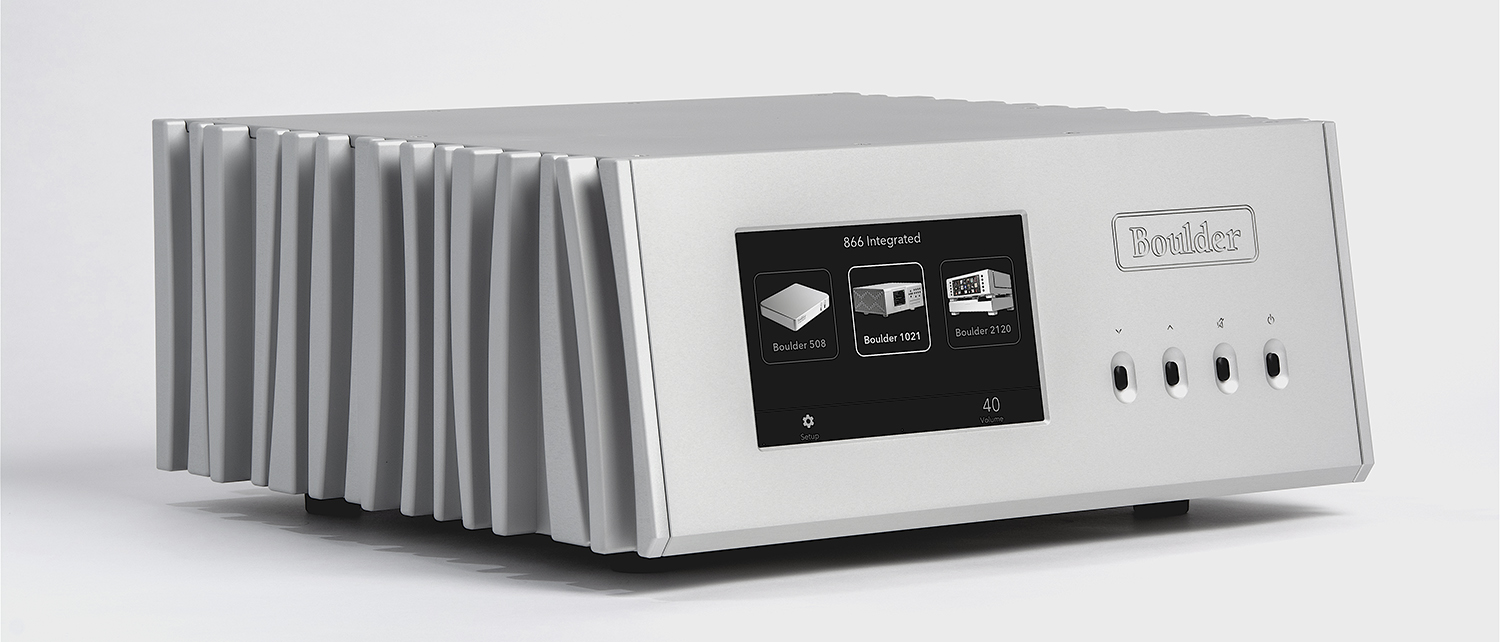What Hi-Fi? Verdict
Considering how much of an improvement the 866 offers over the 865, Boulder could be charging much more for the privilege. Not only does it sound better, but it's more powerful, stylish and affordable than its predecessor, and with the option to add a DAC, this is a real winner.
Pros
- +
Superb sound
- +
Power on tap
- +
Excellent user interface
Cons
- -
Screen sensitivity
- -
Lacking RCA SPDIF input
- -
Headphone output
Why you can trust What Hi-Fi?
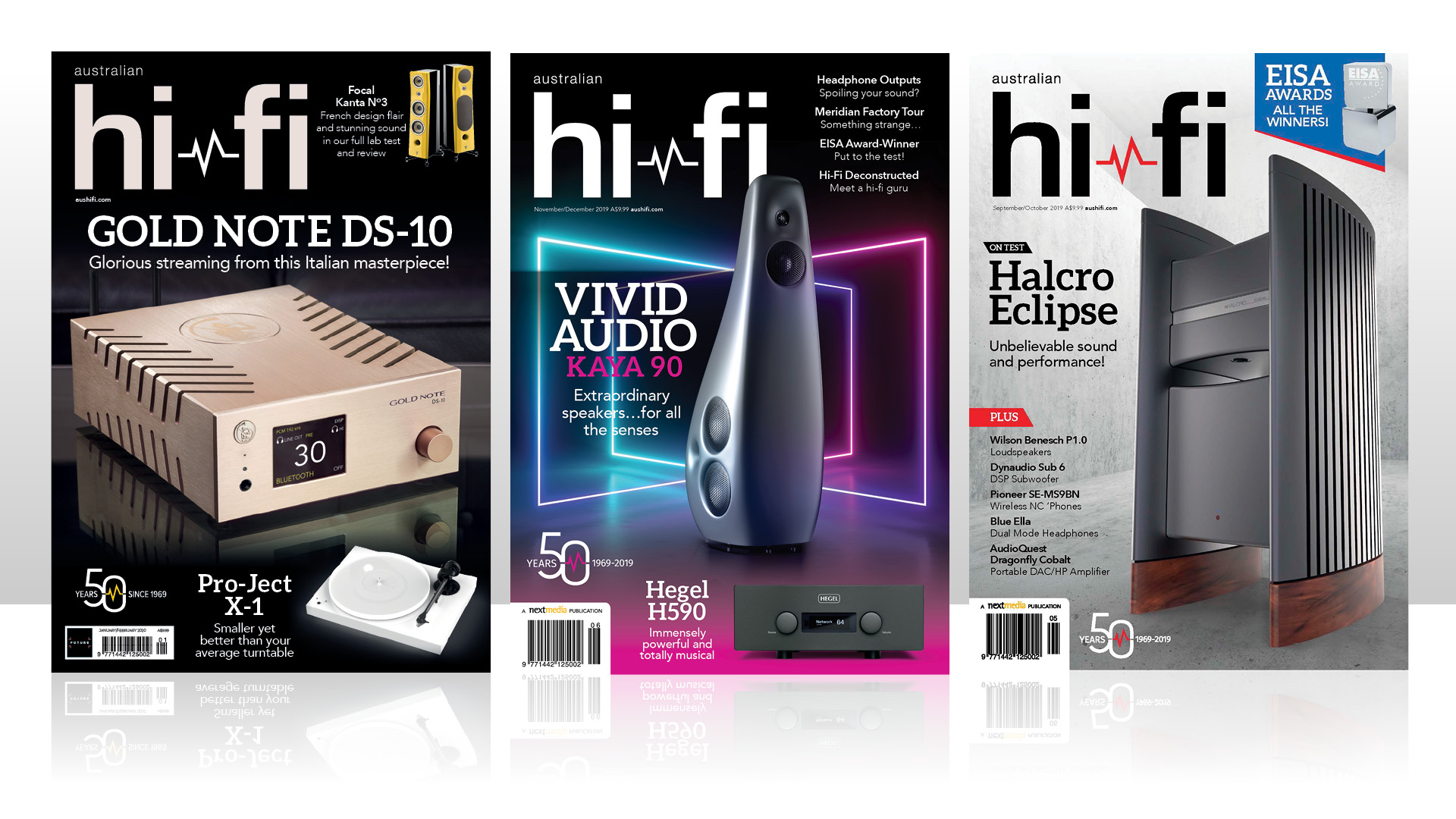
This review and test originally appeared in Australian Hi-Fi magazine, one of What Hi-Fi?’s sister titles from Down Under. Click here for more information about Australian Hi-Fi, including details on how to subscribe.
Boulder makes the bold claim that it builds everything it sells entirely in-house, indeed the company claims to be the last manufacturer in the USA to be doing so.
According to its website: "Along with assembly and testing, every circuit board and piece of metalwork is produced in-house at Boulder’s dedicated facility for unparalleled quality assurance".
It’s perhaps because of this ‘do it in-house’ build philosophy that Boulder does not update models very often, not least because it needs to recoup its research, engineering and tooling costs for each model.
So the new 866 is a very exciting release. It replaces the Boulder 865 integrated amplifier which dates from back in 2007, but the 865 was in essence just a Boulder 810 preamp and 860 power amp coupled on a single chassis, which means that the original design was back beyond the turn of the century. The Boulder 866 is a brand new beast… and what a beast it is!
My only slight disappointment about Boulder is that the company is no longer located in its original home in Boulder, Colorado, from whence it took its name. OK, so the company is still does all its design and manufacturing in good ‘ol Colorado, but now all Boulder products are built in Louisville, Colorado… and Louisville just doesn’t have quite the same ring to it.
I guess it’s just lucky the company didn’t start out in that city, otherwise this might have been a review of the Louisville 866 Integrated Amplifier.
Equipment
Boulder has certainly been bold with the front panel of the 866, because it slopes gently backwards. Very few audio equipment manufacturers have been brave enough to use sloping front panels, but it’s a great idea. It makes the controls on the front panel easier to see and easier to use. Not that the 866 has many controls on the front panel anyway – almost everything is done by using the huge (155 × 85mm) full-colour touch-screen display – but the slope still makes it easier to see and use this display.
The latest hi-fi, home cinema and tech news, reviews, buying advice and deals, direct to your inbox.
You might wonder why sloping panels aren’t more common. Back in the day, the reason was that hi-fi components were always stacked one atop the other, so if you built a component with a sloping front panel it couldn’t be stacked, so you’d dramatically reduce the number of potential buyers. These days cost and complexity are the primary factors. It makes the metalwork more difficult, means you can’t put devices such as sockets or potentiometers low down on the panel (not enough room behind them) and so on. But since Boulder CNC routs all its own metalwork from solid blocks of aluminium, metalwork is simply not a problem for them.
That front-panel display can be used to select inputs (you can also do this via your phone, via Android or Apple app) and input selection is made by swiping the panel to the left or to the right over the input icons until the source you’d like to listen to is displayed, after which you just touch that input icon. Initially I did find that the screen was not entirely responsive to my touch, but I quickly got used to the technique I had to use to make it more reliable. By default, the 866 shows generic icons to identify inputs, but you can replace these with an image of your own, which can be loaded into the amp from your smartphone or tablet.
Boulder suggests that you could take a photo of, say, your CD player and load this as the identifier to use as the icon for the input to which you have that CD player connected. Me, I’d probably take a photo of the company’s logo and load this, but I can also see how you might also have fun using unusual photos (say, of your pets) to identify specific inputs. (No doubt fertile minds will think of other photographic subjects that could be used to identify inputs… your favourite performers perhaps?)
However, if you do choose to buy the base (analogue-only) version of the Boulder 866, you won’t have to do much swiping because it has only three inputs. They’re all balanced inputs (via XLR), but there are only three nonetheless, which is probably too few for most users. What were the designers thinking? The obvious thing to do is opt for the ‘digital’ version of the 866 (which was the version supplied to me for this review), which adds optical and AES/EBU digital inputs, USB inputs, and an Ethernet connection.
I say ‘obvious thing to do’ because while the analogue-only version has a recommended retail price of £13,499 ($12,250 / AU$20,500) it only costs £15,999 ($14,700 / AU$24,500) to get all the bells and whistles, so it’s a no-brainer, really. And if you add in the DAC/Streamer card, you’ll discover that the Boulder 866 also becomes a certified Roon endpoint, so you can use that huge full-colour front panel’s display for media browsing, displaying artwork, text and all the other relevant information for which Roon is justifiably famous. (You do, however, need a Roon subscription, but if you’re unfamiliar with this unique music management/listening solution, and would like to try before you buy, 14-day free trials are available).
Internal DAC
Boulder doesn’t like to talk about the DACs it uses in its products because it says the way the DAC is implemented is as important – or even more important – than the DAC itself.
Boulder’s Sales Manager, Steve Huntley, says that the DAC section inside the 866 is largely derived from Boulder’s flagship 2120 DAC which uses a fairly uncommon delta/sigma DAC that requires a lot of external circuitry support and is not one of the usual ‘plug and play’ DAC chips that most companies use. Boulder also uses an external digital filter of its own design, rather than one of the ‘off-the-shelf’ filters built into the DAC. "We use this DAC chip because we wanted to create a truly optimised DAC section and are not afraid of the complexity required to implement it ourselves," he said.
Accepted sample rates: 44.1, 48, 88.2, 96, 176.4, 192, 352.8, and 384kHz. DSD 1× and 2×. MP3 up to 320kbs. File types include FLAC, WAV, Ogg, AC3, MP3, AIFF, Apple Lossless as well as DSD and network streamable DSD (DSF). All files are upsampled and oversampled to a data rate of 192kHz and data is moved asynchronously.
Features
As you can see from the photographs accompanying this review, the touch-screen isn’t the only way to control the Boulder 866. The four buttons to the right of the screen are for (from left to right): Volume Up, Volume Down, Muting, and Stand-By Power (the main power switch being at the rear of the unit). You can also control the 866 remotely, using an r.f.-to-USB remote control, but you have to, as they say, ‘bring your own’. The USB r.f. receiver dongle will use up one of the USB inputs on the rear of the 866, but because there are four, you’ll still have three others available to you.
Boulder has built ‘smarts’ into the 866’s volume and muting circuitry, because you can preset a turn-on volume, as well as set a ‘maximum volume’ level so no-one can destroy your loudspeakers while you’re away. As for the muting circuitry, you can preset that so the output will be attenuated by any level you choose (so long as you choose a level between somewhere between –6dB and –80dB.)
The default setting is –20dB. Boulder takes great pains to point out that the signal is attenuated by the level you specify relative to the level at which you’re listening so if, for example, you set the mute level to –40dB, the volume will be decreased by 40dB from that level when you press the ‘Mute’ button. I suspect most users will leave it at the default –20dB setting, which I found worked well for me.
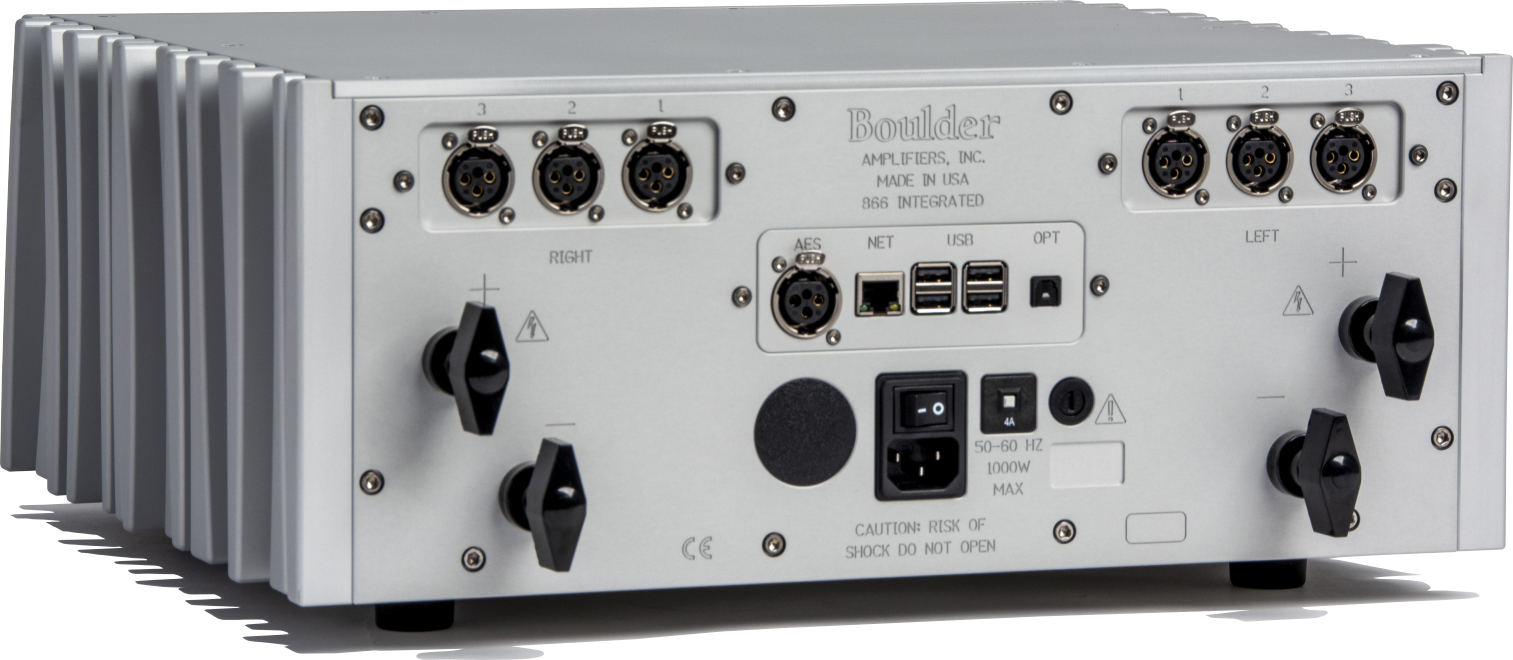
The rear panel of the Boulder 866 is fairly sparse, not least because there are only three analogue inputs, as mentioned previously, and a single set of loudspeaker terminals. Boulder is using a terminal type that is popular with high-end amplifier manufacturers, but is actually not my favourite type of terminal because there are no holes at the end for banana plugs, no holes in the posts for stripped wire or pins, and the conductive area is relatively small. You also can’t remove the knobs to fit ring connectors, so spades are your only really sensible option for speaker wire termination.
The digital inputs are almost exactly in the centre, and from left to right are AES (XLR), Ethernet, four USB Type-A connectors and an SPDIF optical digital input (Toslink). The elephant in the digital input room is an RCA SPDIF input, because there isn’t one. I know you can get an RCA/XLR adaptor for the AES input (indeed Boulder makes one – called DABL – available as an accessory) but I think one should have been included as standard.
Boulder’s Steve Huntley says of the missing RCA SPDIF input: “optical is common for consumer goods like set top boxes, etc… and AES is the performance preference for most people in places like Japan, China, and the USA who use a CD player as a source and want to go digital out of that to the 866.”
Looking from direct-on at the rear panel you’ll find that Boulder has engraved the lettering then added some black into the engraved section which is a pretty classy – and totally permanent – way of doing it. I was also pleased to see that Boulder has avoided one of my pet hates by mounting its mains power rocker switch sideways, rather than vertically. (When US amplifier manufacturers mount rocker switches vertically, they arrange the wiring so pressing the top of the switch turns the amplifier ‘On’ which is the opposite of the way power switches operate in Australia and the UK.)
In use
The first hurdle for many audiophiles who purchase a Boulder 866 may very well be that the equipment they own doesn’t have balanced outputs. This will mean they will have to make up an ‘unbalanced to balanced cable’ using one of the two methods Boulder describes in its Owner’s Manual, or buy one (though most of the ones available for sale will use a wiring method that Boulder says is inferior).
Possibly the best option would be to purchase an RCA to XLR adaptor (Cat PA3800 at Jaycar), though this also uses Boulder’s ‘second-choice’ wiring method. Frankly, given the price Boulder is asking for the 866, I think the company could afford to include either cables or adaptors in the box.
I found firing up the Boulder from cold to be a time-consuming business. When I first pressed the power switch, I thought my review unit was, as they say, ‘dead out of the box’, because nothing at all happened. Then, after six seconds, the screen sprang to life, with a small Boulder logo and a short line underneath displayed on it. But then nothing happened… for a long time. Well, 26 seconds actually, but it seemed longer, after which the screen flashed momentarily and the words ‘Initializing System’ came on underneath the short line. Then nothing happened… for a long time. Well, 34 seconds actually, but it seemed longer, after which the 866 finally turned on. But then, rather than staying on, it then turned itself off! Whaat?
Initially I thought that I must have accidentally wired the speaker outputs wrongly (those + and – symbols are a little hard to see and there’s no colour coding), or that the amplifier had detected an internal fault and switched itself off for self-protection. But no, it turned out that the 866 had not turned itself off at all, but had just gone straight into Standby mode instead. So I pressed the power button on the front panel, rather expecting a long wait, but thankfully the screen immediately lit up, showed the words ‘Resuming from Standby’ and six seconds later I was good to go. Phew!
Well… good to go after I’d warmed the amplifier up, which didn’t take too long, because it actually runs pretty hot. All those bars along the sides of the amplifier that look like they were designed by Frank Gehry (the famous architect) and are presumably intended to dissipate heat certainly look fantastic, but they don’t dissipate heat nearly so well as the ugly black finned stuff does! (By the time you read this, the start-up process may have been sped up by a software update (V0.85) released earlier this year, but this newest version was not available prior to my deadline).
The sound. What can I tell you about the sound? It’s not great. By which I mean that it’s excellent… extraordinarily good, in fact. So exceptionally good that you won’t have to spend hours in lengthy listening sessions, auditioning track after track after track in order to establish its quality: you’ll know in the first few instants that you’re listening to a remarkable amplifier. For starters, the 866’s control over bass is exceptional. If you thought your speakers delivered tight, taut and rhythmic bass, you won’t really have heard them until you’ve connected them to Boulder’s 866. The tonal quality, the depth of the bass, the perfect pacing of bass lines, the dynamism revealed by the sound from a close-miked drum kit… the Boulder 866 has it all in spades. No, it’s better than just spades, it’s a full lay-down misère.
To further check out the 866’s power reserves I switched albums and set the volume of Louisa Rose Allen’s ‘Glorious’ to ‘stun’ to check out whether the overblown kick drums and synth bass notes on it would push the 866 into clipping. No chance! Not only did I not hear any clipping, I could not hear any type of distortion at all… the sound remained as clean as a whistle, even though I was playing back so loudly I was essentially listening from the next room in order to protect my hearing. I can truly believe Boulder’s claim for 200-watts per channel into 8Ω and that it doubles to 400-watts into 4Ω.
To give my ears a break from the noise and to also try out the Boulder 866’s inbuilt DAC, I switched to a 192/24 recording of ‘Unfold’ where the Kreutzer Quartet plays works by Australian composers Don Banks, Nigel Butterley, Richard Meale and Felix Werder. All the compositions on it depend on perfect timing, yet timing that is mostly organic rather than dictated by the music… as evidenced by Butterley’s String Quartet (1965) where in the second movement, there are no bar lines, and the players are directed that ‘the upper parts are independent of each other, but each player should relate his part fairly closely to the cello part.’ I found the reproduction to be perfect. The sound of all the instruments was sweet, pure and perfectly accurate, and when low-level sounds died away into the acoustic – such as on Meale’s String Quartet No 1 – the silence at the end was absolute. There was absolutely no circuit noise whatsoever audible from the Boulder 866. It’s so noiseless that I’d venture to say that it’s the quietest amplifier I have ever auditioned.
I trialled the DAC section with Art Halperin’s ‘Winds of Change’ which, thanks to the good graces of Barry Diament, of Soundkeeper Recordings, I have in all available digital formats. The Boulder 866 treated each with equanimity. No matter what your preferred digital format, the 866’s DAC section will deliver exactly the musical information recorded, from MP3 through to high-res, after which the analogue amplification that follows will add the coup de grâce.
Zappa’s remastered ‘Apostrophe/Overnight Sensation’ proved to be yet another sonic tour de force from the Boulder 866, from the insane sound of the guitar on Fifty/Fifty, to the trumpet squawk in Zombie Woof and the joy of hearing Zappa’s perfect enunciation of such a perfect line as ‘like a pink donation to the dragon in your dreams’ (Dirty Love). Perfectionist that he was, all of Zappa’s recordings are superb for test tracks because he was as fanatical about recorded sound quality as he was about getting his – and everyone else’s – performances perfect.
Listening to Amarillo’s ‘Eyes Still Fixed’ the purity of the sound from Nick O’Mara’s lap steel guitar was true to life, but the sonic transparency with which the Boulder 866 rendered the wordless vocals by Jac Tonks on the title track was jaw-dropping. I listened to her perfect pitching and the way the layers built, both of her voice and the accompanying instruments, with increasing astonishment. Could an amp really sound this good?
Listening to a recording of one of the largest choirs I have heard, singing Handel’s Messiah at Sydney Opera House, the choral sound was just as I remembered from the night (the CD was recorded at the self-same concert I attended). The detailing of the individual voices amongst the full-bore choral onslaught was absolutely astonishing and there was none of the blurring that I’ve heard from other amplifiers. The sound-staging was such that I pinpointed the positions of the soloists instantly, and they were positioned on the reproduced stage exactly where they were standing on the real stage on the night. The sound from the massed sopranos was so beautiful it brought tears to my eyes on the night, and it did so again when I was auditioning the Boulder 866… and when an amplifier produces sound so unbelievably good that it evokes an actual physical emotional response, I can tell you that you don’t really need to continue auditioning. You know everything you need to know.
Final verdict
The new Boulder 866 is more powerful than the amplifier it replaces and it’s also electronically and sonically superior to that amplifier. It’s also much better-looking… or at least it is in the opinion of everyone that I asked. Because of this I was – quite frankly – expecting Boulder to be charging quite a lot more for it than it is. Indeed I was more than a little surprised to discover that a standard Model 866 costs less than the equivalent 865 did when it was available.
Of course the price rises if you add the digital option (and you’d be mad not to add in the DAC!) but considering that you’re buying what is essentially a custom hand-built amplifier with a great DAC on-board – and a Roon endpoint – that sounds absolutely superb and has more power than you’ll ever need, you are most definitely getting top value for your hard-earned. This is an amplifier you will keep… and enjoy!… for the rest of your life.
Lab test results
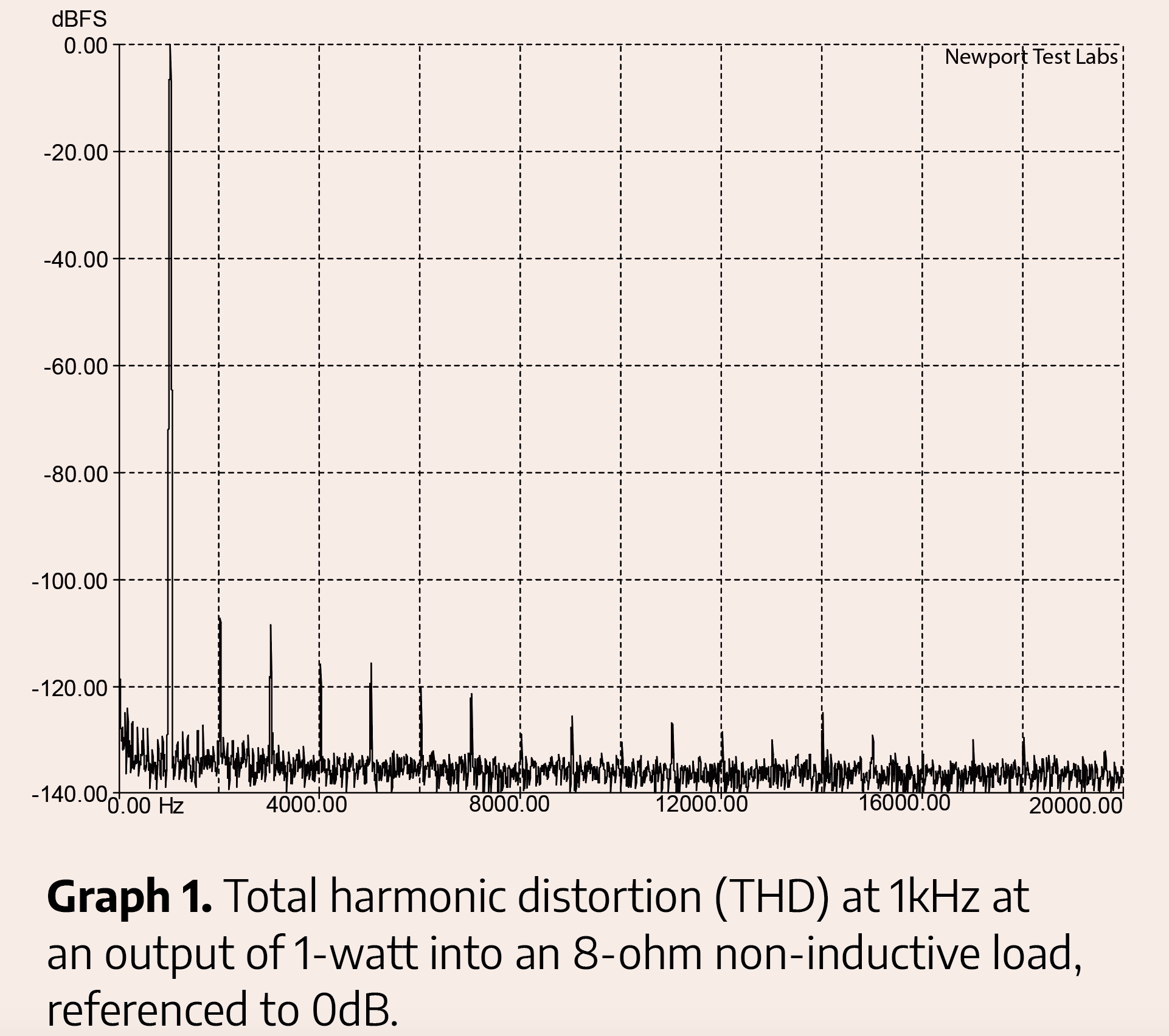
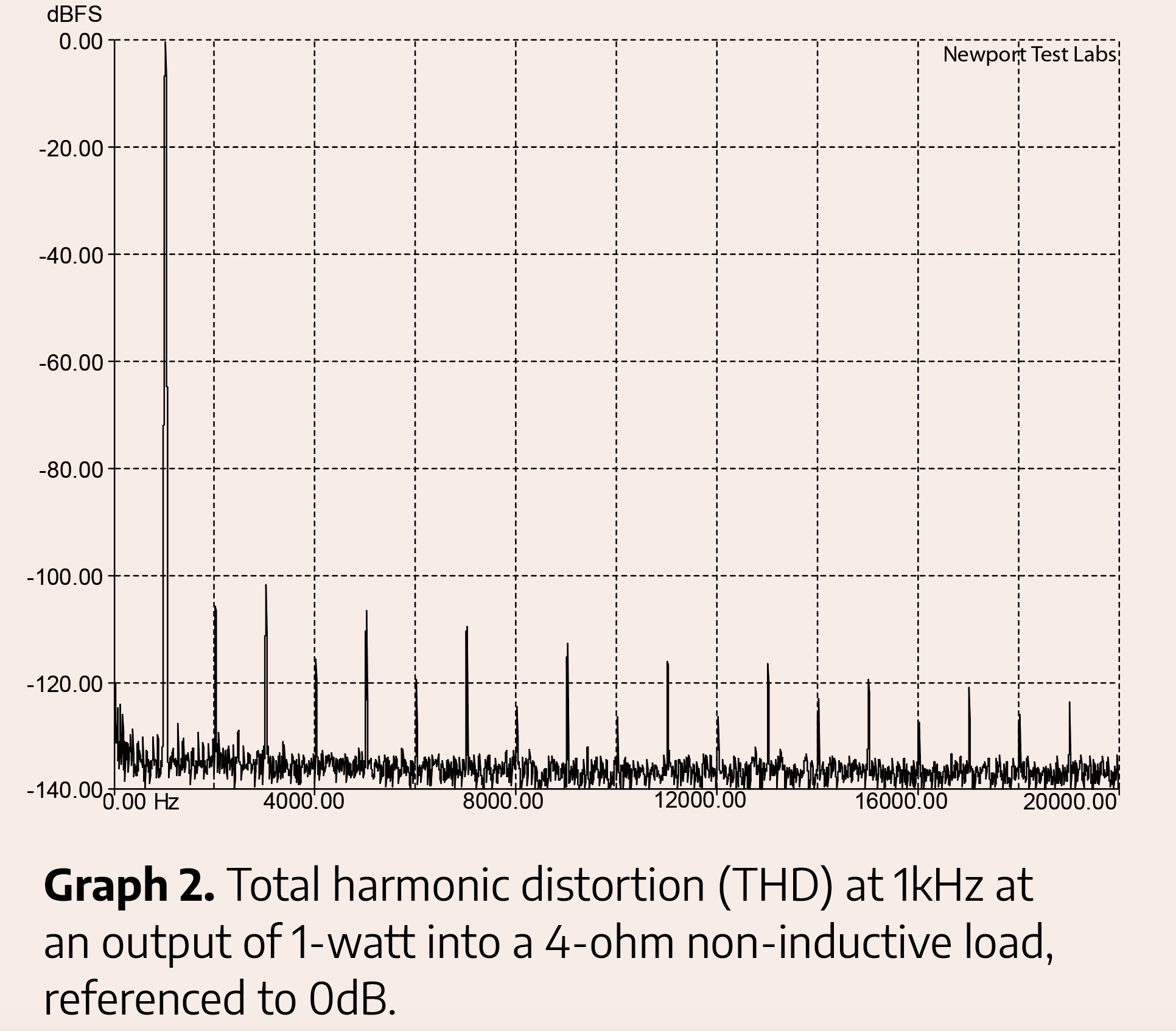
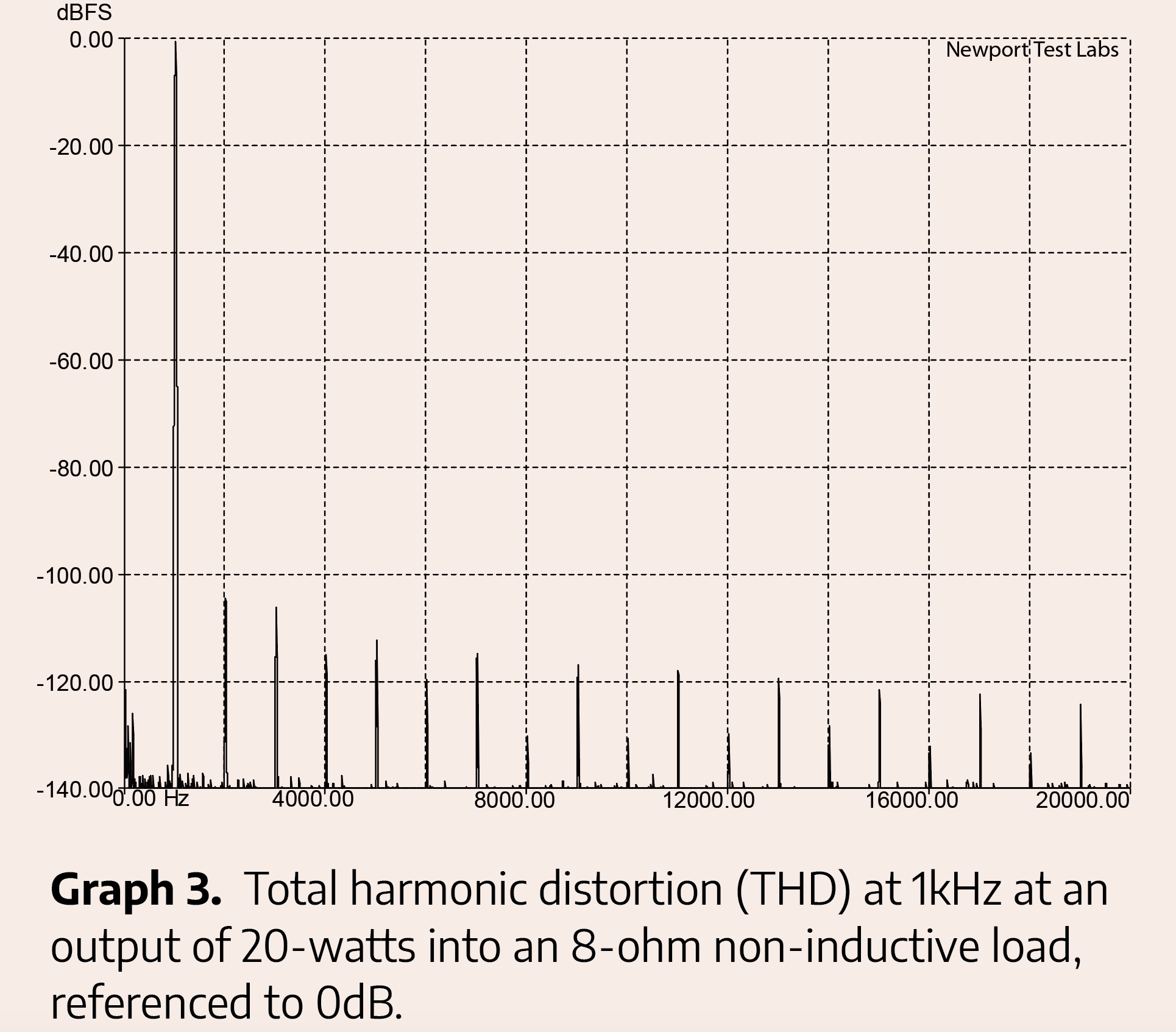
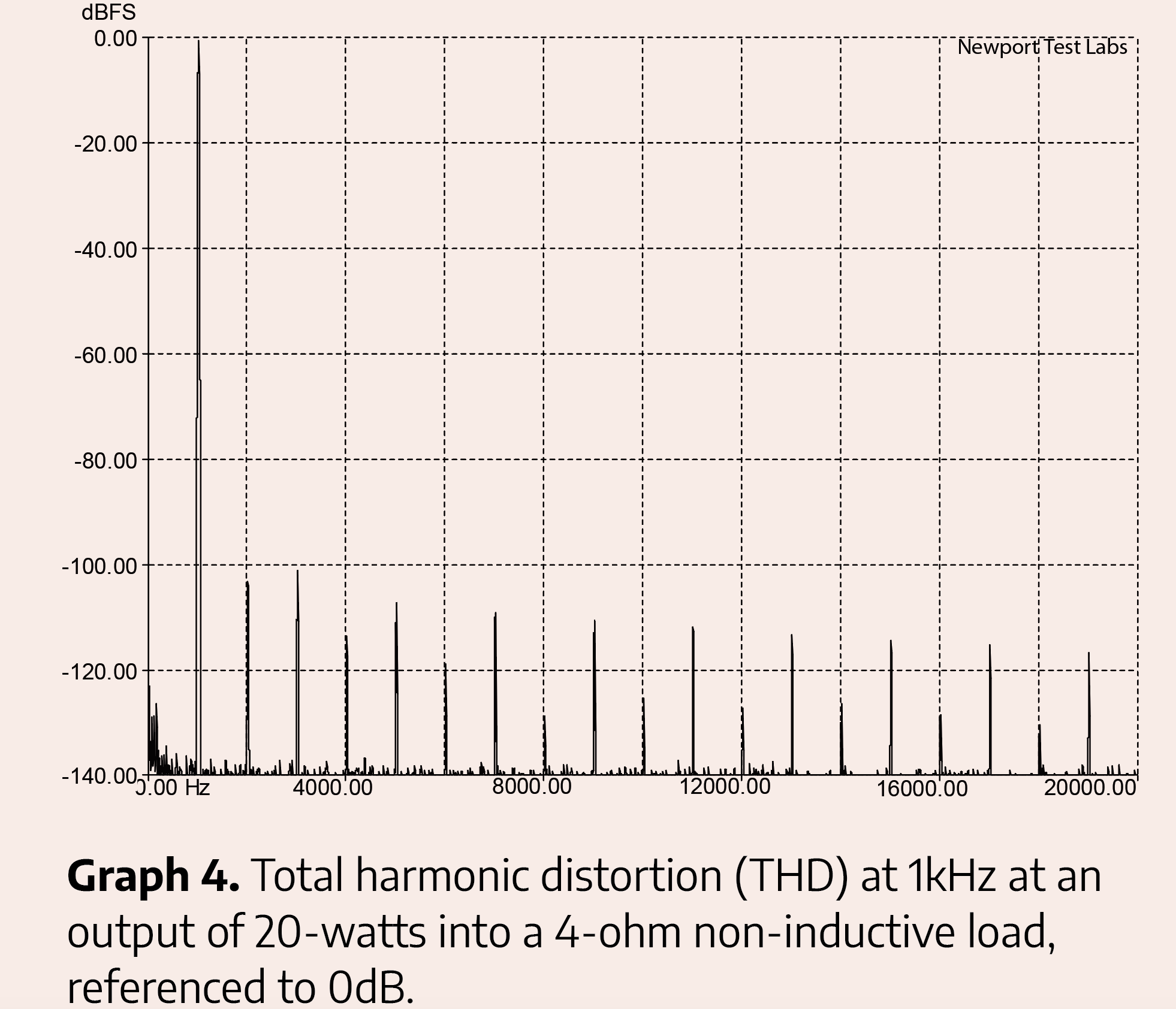
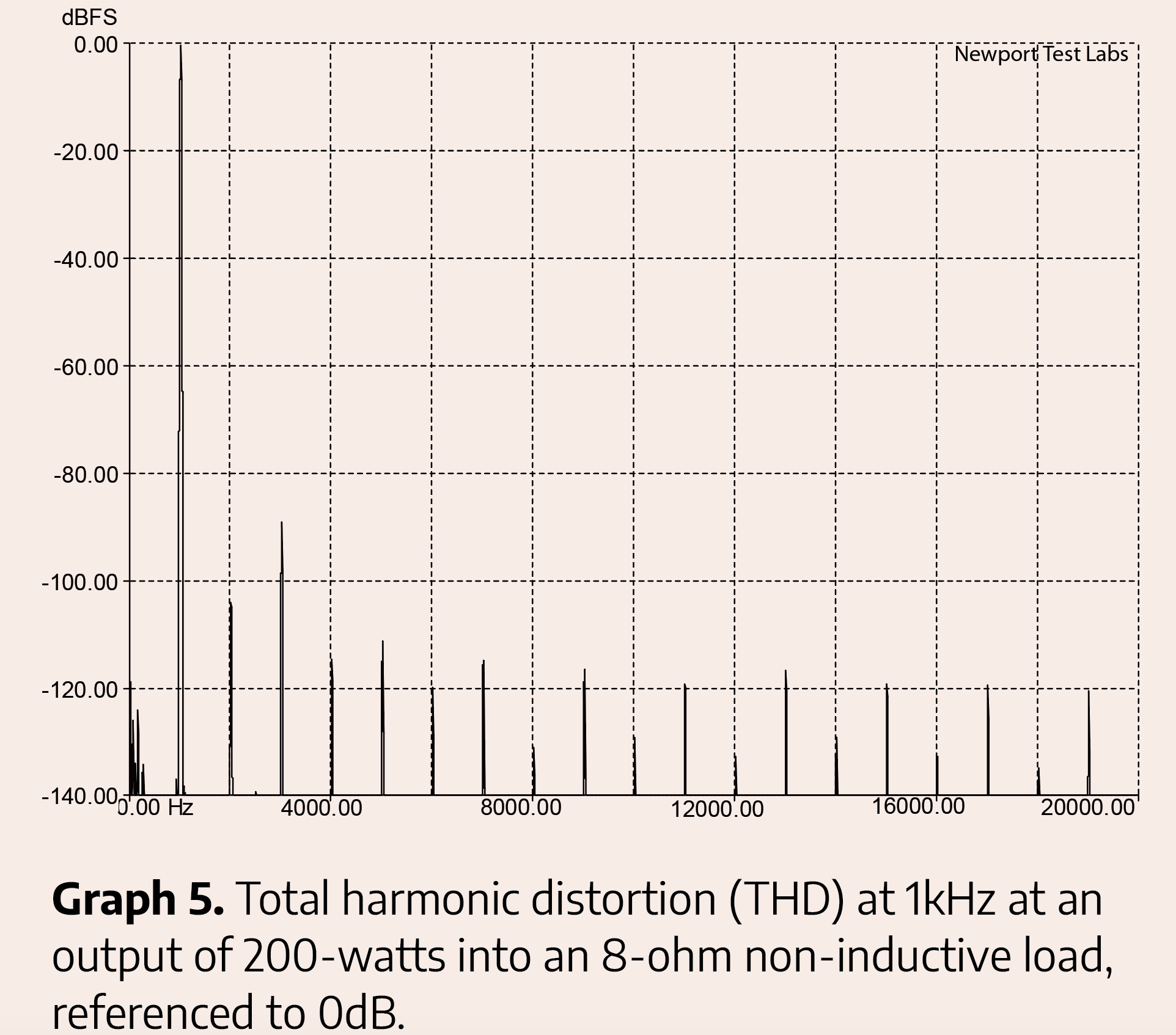
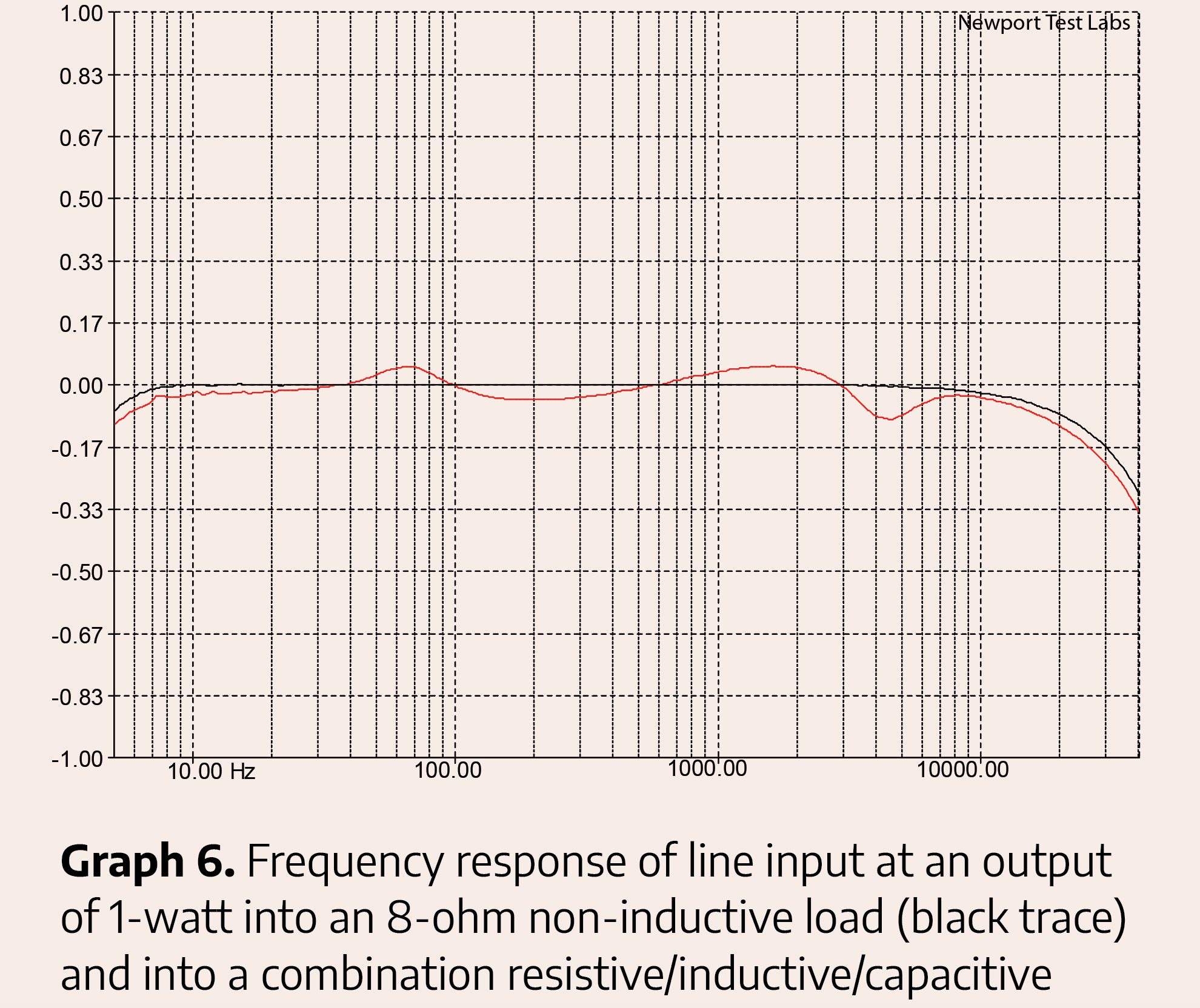
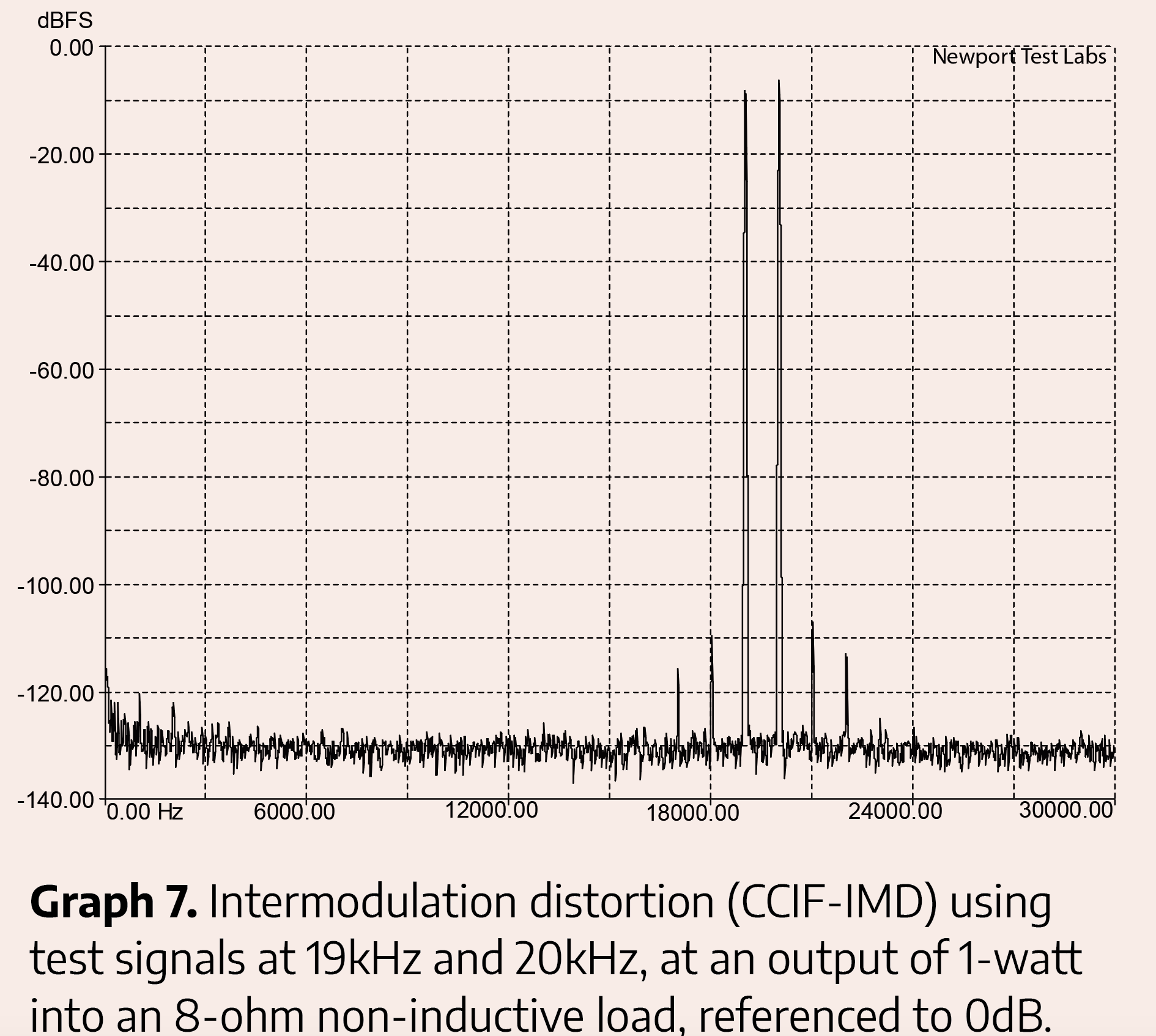
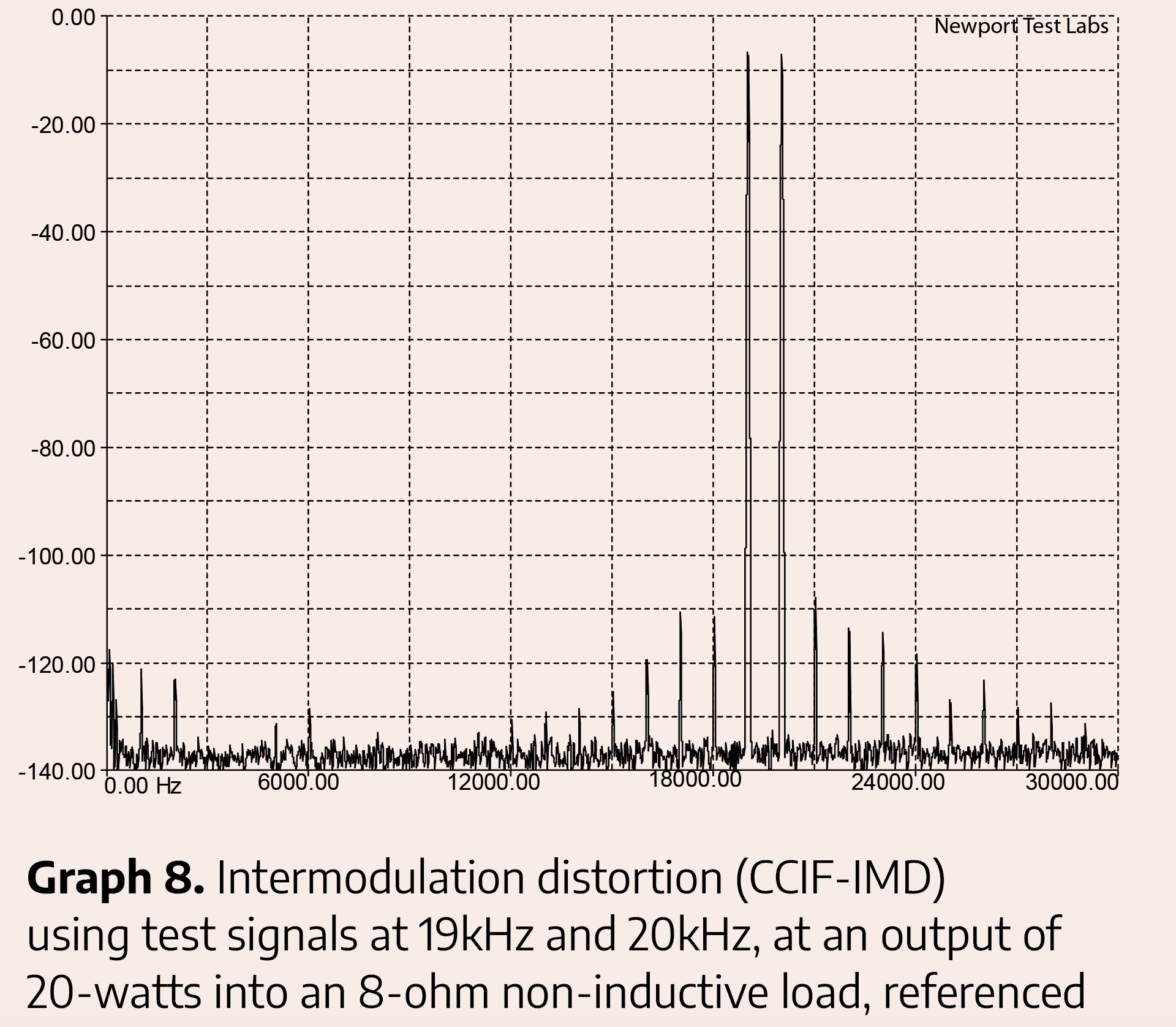
The very first measurements made by Newport Test Labs were of power output. The lab’s results are shown in the accompanying Test Result table and also shown as bar graphs. Measured into 8Ω loads with just a single channel driven, the Boulder 866 delivered 248-watts irrespective of test frequency for all frequencies from 20Hz to 20kHz.
When both channels were driven into 8Ω loads, the 866 delivered 221-watts per channel at 1kHz, 215-watts per channel at 20Hz and 224-watts at 20kHz. As you can see, all these measured results exceeded Boulder’s power output specification for the 866.
Tested with a single channel driven into 4Ω, the Boulder 866 delivered 418-watts at 20Hz, 422-watts at 1kHz and 436-watts at 20kHz. However, when Newport Test Labs tried to repeat the test with both channels driven into 4Ω, the circuit breaker on the rear panel of the Boulder 866 tripped well before the amplifier’s maximum output could be measured, with the breaker tripping at 380-watts with a 20Hz test signal and at 400-watts at higher frequencies. This action was no doubt due to the continuous nature of the test signal tricking the protection circuitry and means that when playing music, the Boulder will deliver more than 400-watts per channel (i.e., more than its rated power) into 4Ω loads.
Newport Test Labs measured the frequency response of the Boulder 866 as 3Hz to 71kHz ±0.5dB and 3Hz to 122kHz ±1.5dB, proving it to be a very wideband design. The frequency response across the audio band was exceptionally good, which I’ll get to later in this report. Channel separation was outstandingly good for a single-chassis amplifier, with Newport Test Labs reporting separation of 114dB at 20Hz, 132dB at 1kHz and 115dB at 20kHz. Although all those results are great, the result at 20kHz is exceptionally good. There are very, very few amplifier that can deliver three figure separation results at 20kHz.
Channel balance was also excellent, with the lab reporting a difference at 1kHz of only 0.09dB. Channel phase errors were almost unmeasurably low at low frequencies, and while the result of 1.32° at 20kHz was certainly measurable, it would be imperceptible to the human ear.
Distortion was vanishingly low… so low that I am really covering it simply from a technical standpoint, because it is so low that it will be completely and absolutely inaudible. You will not hear distortion from this amplifier… at any power level. Take for example, the Boulder 866’s distortion signature when delivering 1kHz at an output of 1-watt into an 8Ω load, which is shown in Graph 1. There are harmonics out to 20kHz, but all except the four lowest are more than –120dB down, or less than 0.0001% THD. As for the four that are higher in level than this, we’re looking at a second harmonic at –108dB (0.00039% THD), a third harmonic at –109dB, and a fourth and fifth at 115dB (0.00017% THD). Putting aside the point that any distortion amount that has three zeros after than decimal point would not be audible, you also need to consider that even if they were audible, the second and fourth harmonics in particular would enrich the sound quality substantially, while the third would give a pleasing fullness to it. In other words, even if you could hear them, they’d benefit the sound quality and would not be perceived as distortion per se.
Although all the foregoing would also apply to the more obvious distortion that is visible in Graph 2, the increase in the level of the odd-order harmonics (3rd, 5th, 7th, etc) and the overall increase in the level of all the harmonics, both odd and even, shows that the Boulder 866 will be more comfortable driving 6Ω and 8Ω loudspeakers... and given the amount of power available, as already outlined, it will have absolutely no difficulty providing more than adequate power into these impedances.
Graph 3 shows the Boulder 866’s distortion when delivering 20-watts into an 8Ω load and the most striking feature of this graph is the amplifier’s overall noise floor, which has dropped down below the graphing limit of –140dB, and the level of power supply noise, which is shown by the small cluster of signal components at the far left edge of the graph. At this higher output level, all except the good-sounding second and third harmonic distortion components (if you could actually hear them, that is) are lying at more more than 115dB (0.00017%) down, and the second harmonic is at –105dB (0.0005%) and the third at –107dB (0.0004%).
Newport Test Labs’ measurement of distortion at 20-watts into 4Ω shows that despite the Boulder 866 being more comfortable with 8Ω loads, distortion levels for all except the second, third and fifth-order component are still more than –115dB down at the lower resistance load. Into 4Ω loads the second harmonic is at –103dB (0.0007079%), the third at –101dB (0.0008913%) and the fifth at –114dB (0.0001995%).
Why is Newport Test Labs now measuring distortion at an output of 20-watts? Because this is effectively a ‘worst case’ scenario for any audio amplifier. Distortion at power levels above and below this will almost certainly be lower, as you can see by looking at Graph 5, which shows the Boulder 866’s distortion signature when delivering its full rated output (200-watts) into an 8Ω load. You can see that distortion is totally under control and completely inaudible… even that prominent third harmonic at –90dB (0.0031%).
The frequency response of the Boulder 866 was so flat and linear across the audio band that Newport Test Labs provided us with a graph with a vertical scale of only ±1dB rather than ±3dB, which is the more usual scaling for this measurement. The black trace on this graph shows the 866’s performance into a standard laboratory test load (a non-inductive 8Ω resistor) and you can see that the response is ruler-flat down to 9Hz and just 0.04dB down at the graphing limit of 5Hz. At high frequencies, the response starts ‘rolling off’ just above 3kHz to be 0.3dB down at 40kHz. The response across the audio band is 20Hz to 20kHz ±0.04dB.
The red trace on Graph 6 shows the Boulder 866’s frequency response when driving a special test load that simulates the load that would be presented to it by a typical two-way bass-reflex loudspeaker. Although it’s not quite so linear, as you can see, the variations in level are actually tiny and only visible because of the greatly expanded vertical scaling of the graph, such that the measured response across the entire graphed area is 5Hz to 40kHz ±0.19dB, and across the audio band is 20Hz to 20kHz ±0.07dB. This performance means not only that the Boulder 866’s response will be perfect to the ear, but also that this same response will be delivered irrespective of the impedance of the loudspeakers you use in conjunction with it.
Intermodulation distortion (CCIF-IMD) is shown for a one watt output (Graph 7) and again for a ‘worst-case’ 20-watt output (in Graph 8). In Graph 7 you can see the two test signals at 19kHz and 20kHz to the right of centre of the graph. There are only four unwanted sideband signals, two at around –110dB (at 17kHz and 21kHz) and two at around (–115dB). This is excellent performance. But even more importantly, there is almost no regenerated difference signal down at 1kHz. There is, but it’s sitting 120dB down (0.0001%). There’s a little more IMD visible when the output is increased to 20-watts (Graph 8) but all of it is more than 110dB down, and the regenerated 1kHz signal is still more than 120dB down.
As you’d expect from the superb results Newport Test Labs measured in the frequency response tests, the square wave performance of the Boulder 866 is exemplary. The 100Hz result was indistinguishable from the signal from the square wave generator itself. The rise time is perfect, the top is perfectly flat and is exactly at 90° to the leading and trailing edges. The same analysis is true for the 1kHz square wave… indeed if it were not for the screen captions, it would be impossible to tell them apart.
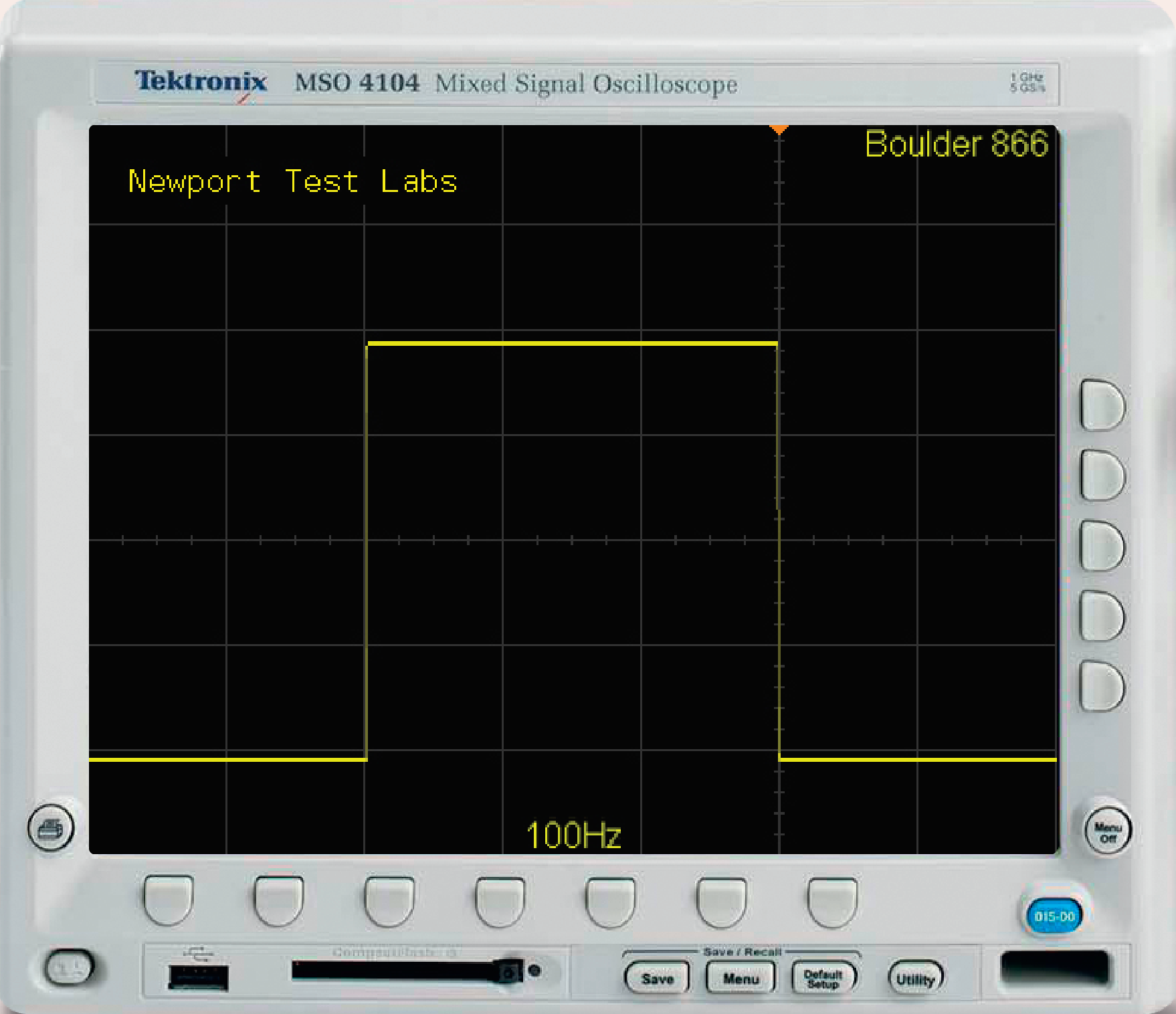
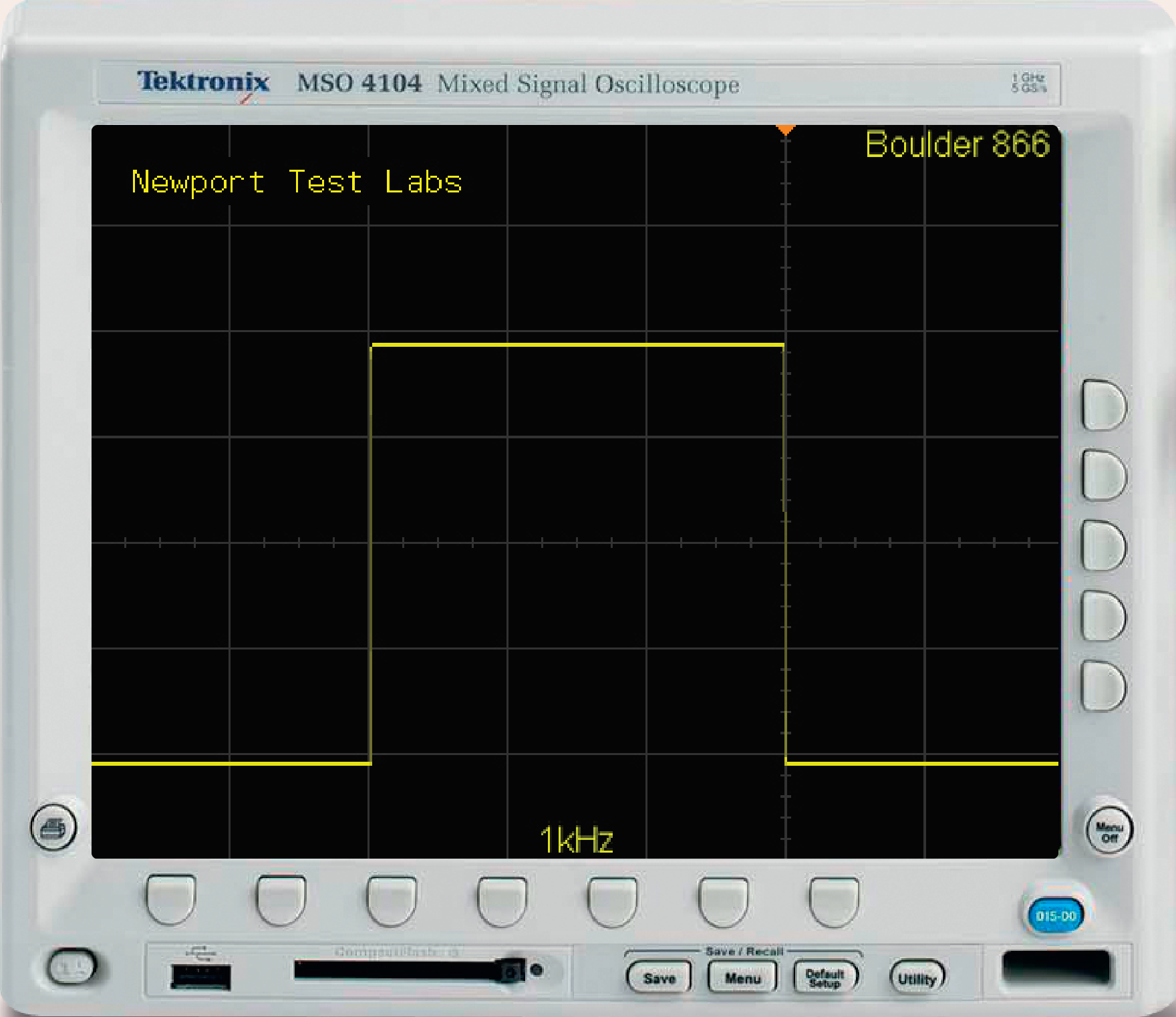
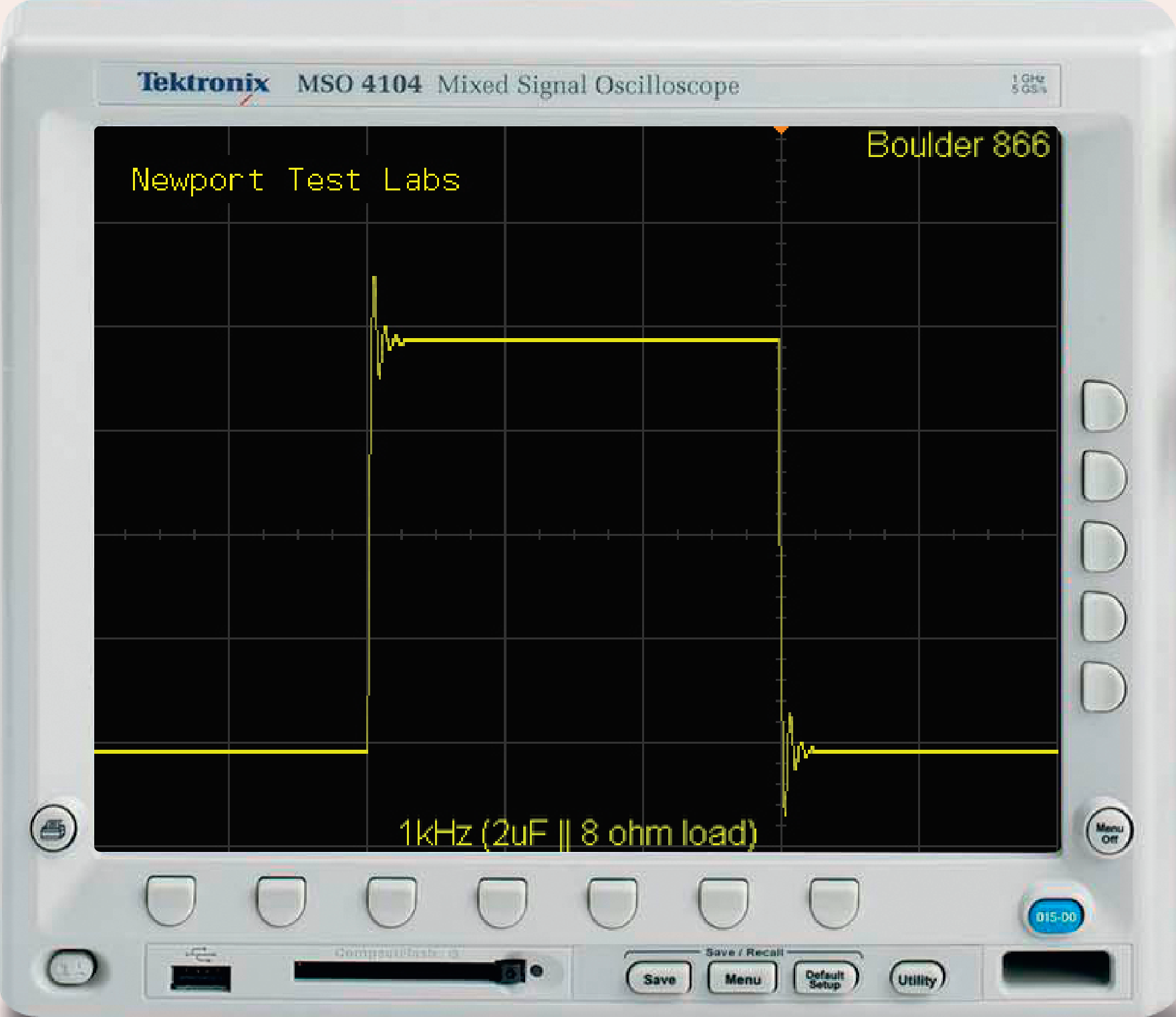
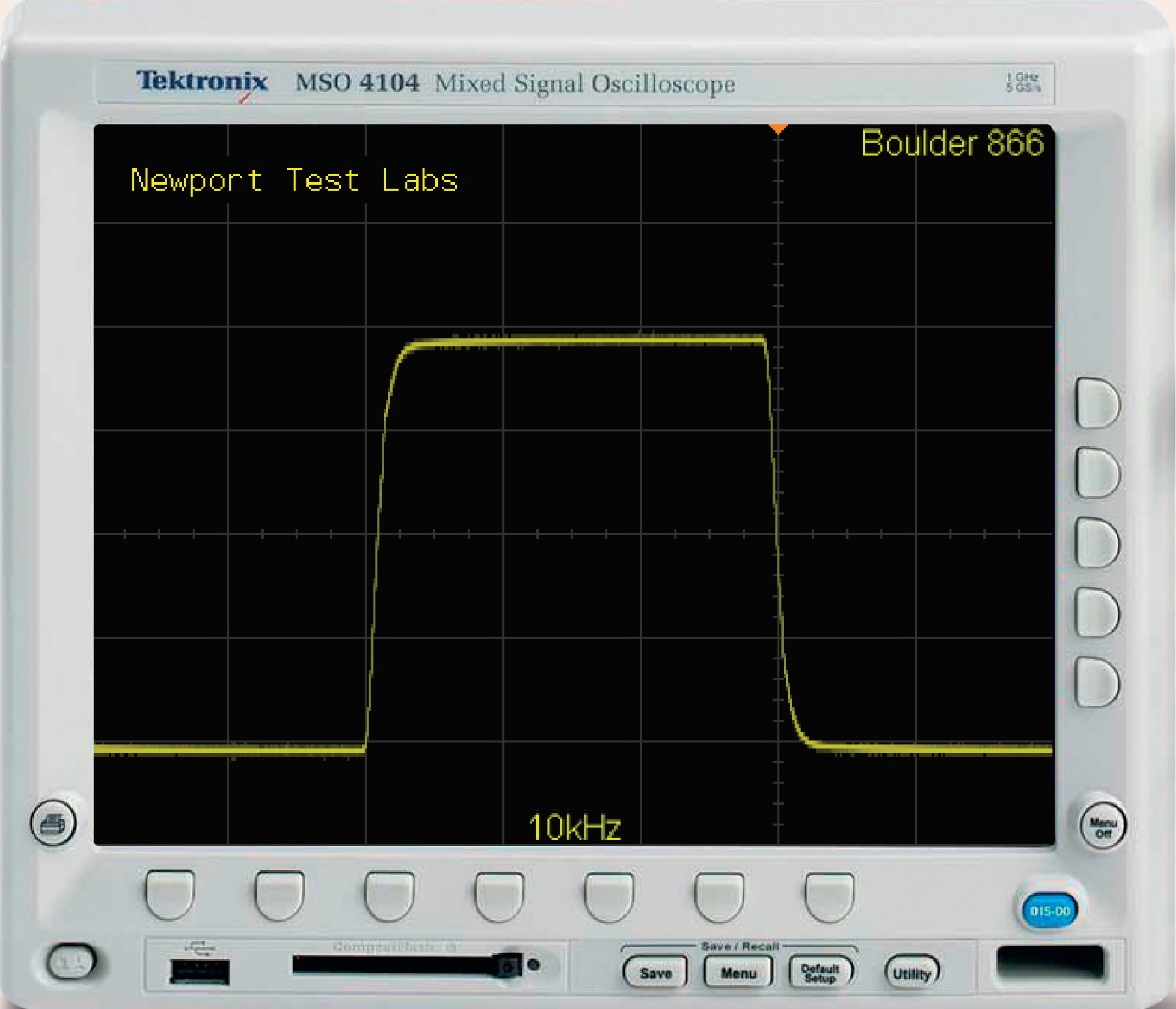
It isn’t until we look at the 10kHz square wave that we see some output stage rise-time limitations causing the leading edge to lean away from the vertical, but this is still an excellent result, far better than I am used to seeing at this test frequency. The Boulder 866’s performance into a highly reactive load was also outstanding, with just a tiny overshoot of perhaps one-eighth wave height, and the ringing from the overshoot damped within three cycles. This is an amplifier that will be unconditionally stable into any loudspeaker load.
The signal-to-noise ratios measured by Newport Test Labs were also outstanding, something you may have already guessed if you’ve looked at the amplifier’s noise floor on the graphs of distortion at various levels. Referenced to a one-watt output, the signal-to-noise ratio was 93dB unweighted and 98dB A-weighted. Referenced to rated output (200-watts) the Boulder returned results of 111dB unweighted and 116dB A-weighted. All four results are exceptionally good.
Input sensitivity was 82mV for one watt output and 1.15V for rated output, so you won’t have to be particular about the components you connect to the Boulder 866 – it will happily interface with any component I’ve ever run across.
Newport Test Labs measured the output impedance of the Boulder 866 as being 0.06Ω at 1kHz, which gives a damping factor of 133, which means that the amplifier will have total control over the back-emf from even the largest driver cones. It’s an excellent result – one much better than it needed to be, in fact.
As you’d expect for a high-powered Class-AB design, mains power consumption at rated output was also high, with the Boulder 866 pulling 708-watts from the mains when working hard, and around 400-watts under normal operating conditions. And unlike many Class-D designs, it’s not contaminating the mains power delivered to your other components, thanks to a power factor of just 0.693. As you can see from the tabulated figures, power consumption was still high (93.91-watts) when the amplifier was switched on but not actually being used and even in Standby mode power consumption was higher than the figure mandated by the Australian government.
The Boulder 866 returned outstandingly good results across every area of performance when it was tested on Newport Test Labs’ test bench. Its performance is so good that I was reminded of an aphorism that was popular back in the 80s when university lecturers were telling their students about what to aim for when designing an audio amplifier. “A straight wire with gain,” is what we were told. I think Boulder has come as close to that as I have seen.
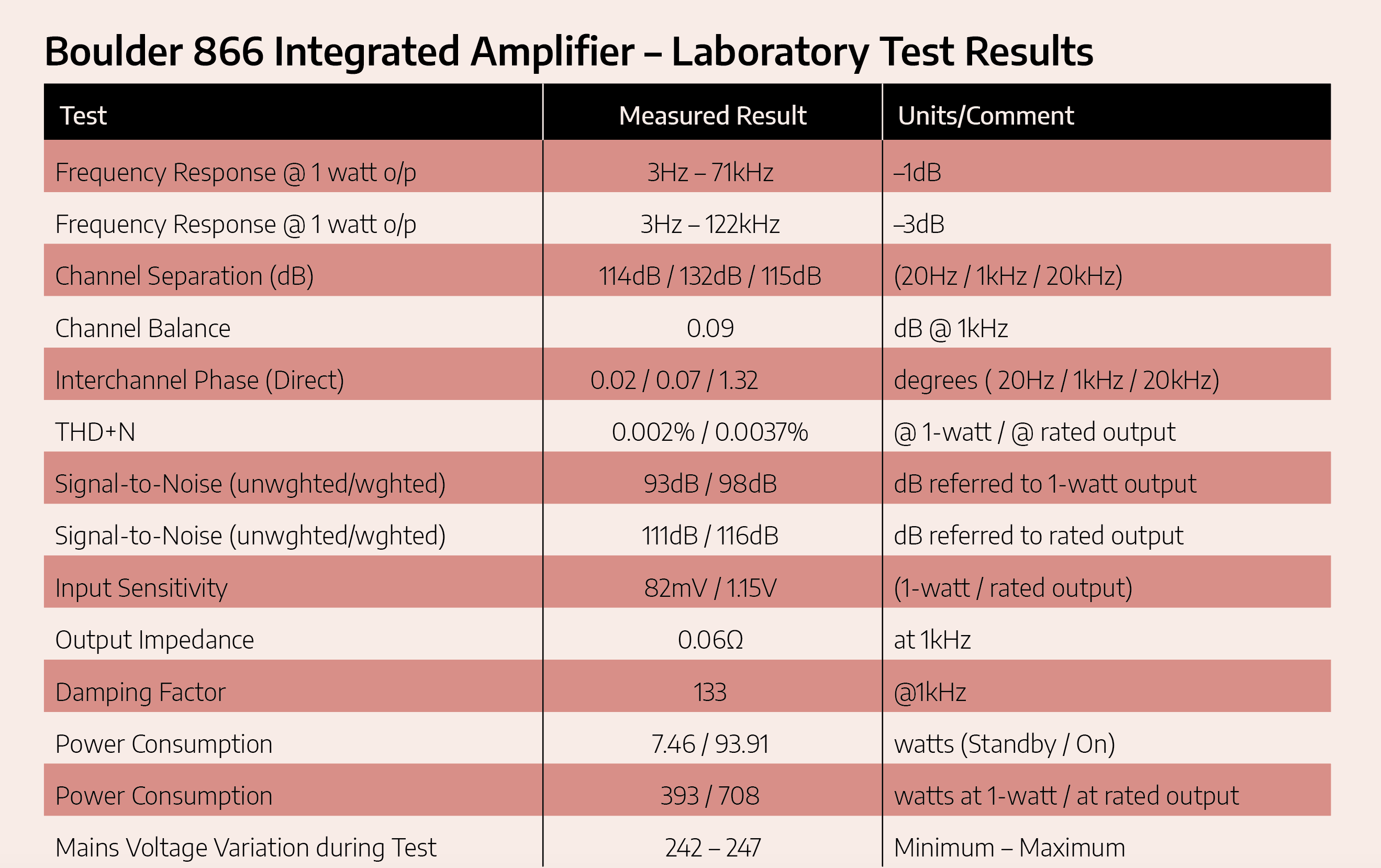
Australian Hi-Fi is one of What Hi-Fi?’s sister titles from Down Under and Australia’s longest-running and most successful hi-fi magazines, having been in continuous publication since 1969. Now edited by What Hi-Fi?'s Becky Roberts, every issue is packed with authoritative reviews of hi-fi equipment ranging from portables to state-of-the-art audiophile systems (and everything in between), information on new product launches, and ‘how-to’ articles to help you get the best quality sound for your home.
Click here for more information about Australian Hi-Fi, including links to buy individual digital editions and details on how best to subscribe.
